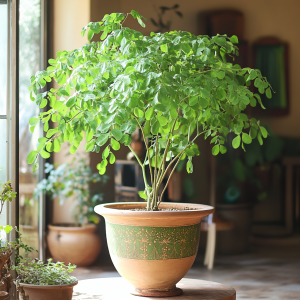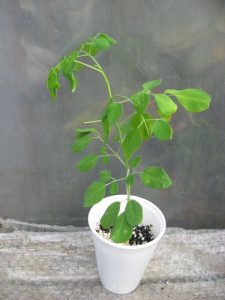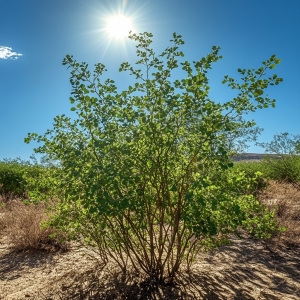
You can grow the moringa plant indoors in a sunny spot
If there were a “Swiss Army knife” of plants, it would be Moringa oleifera. This isn’t your average backyard herb—this is the powerhouse of all powerhouses. If you could only grow one thing to keep yourself nutritionally fortified in an off-grid, grid-down, or just plain “I forgot to go grocery shopping” scenario, Moringa is it. It’s a tree that doesn’t just survive but thrives, offering an abundance of benefits in nearly every part of it. Let’s dive into why this plant is the secret weapon for self-reliant living, how to grow it, and how to use it.
Nutritional Jackpot!
Moringa isn’t just another leafy green—it’s a nutritional goldmine. The leaves contain a powerful mix of protein, including all nine essential amino acids, along with an abundance of vitamins such as more vitamin C than oranges, more vitamin A than carrots, and more potassium than bananas. The mineral content is just as impressive, packed with calcium, iron, and magnesium. On top of that, it boasts high levels of antioxidants, making it a natural ally in fighting inflammation and promoting overall health. Moringa has long been used for medicinal purposes, supporting immune function, energy levels, digestion, and even water purification.
Medicinal Benefits
Moringa has a long history of being used in traditional healing practices. Its high antioxidant content helps to reduce inflammation and combat

Moringa seedling. Moringas grow 15 feet tall
oxidative stress, making it a natural remedy for arthritis, joint pain, and other inflammatory conditions. The leaves and seeds are known to support cardiovascular health by helping to regulate blood pressure and cholesterol levels. Additionally, Moringa has antibacterial and antifungal properties, making it useful for treating infections and wound healing. The plant is also used to regulate blood sugar levels, making it beneficial for individuals managing diabetes. Its rich iron content helps combat anemia, while its detoxifying properties aid in liver function and digestion. Some cultures use Moringa as a natural galactagogue to support lactation in nursing mothers. The flowers and leaves have been traditionally brewed into teas to alleviate stress, improve sleep, and boost overall energy. With its ability to address multiple health concerns naturally, Moringa is a powerhouse for holistic well-being. However, caution should be taken with the roots, as they contain spirochin, a potentially toxic alkaloid. Consuming large quantities of Moringa root may lead to neurotoxic effects, including paralysis, and should be avoided or used sparingly under guidance.
How to Grow Moringa
The best thing about Moringa? It’s practically indestructible. It thrives in poor soil, laughs at drought conditions, and grows like it has rocket fuel in its roots. This plant loves warm, tropical to subtropical climates (zones 9-11), though it can be grown in colder regions as an annual or in pots that can be moved indoors during winter. It prefers well-drained, sandy or loamy soil but will tolerate poor soil as long as it’s not waterlogged. Full sun exposure is best, requiring at least six to eight hours a day. While drought-tolerant once established, young plants need regular watering. Its growth rate is nothing short of astonishing, shooting up to fifteen feet in a single year. Moringa can be grown from seeds or cuttings, with seeds best planted directly in the ground or in deep pots to avoid disturbing its taproot. Cuttings can be placed in water or moist soil to root. Moringa is forgiving, making it perfect for self-reliant individuals who have other survival skills to master.
How to Use Moringa
Preppers love multi-use items, and Moringa delivers in spades. Almost every part of the tree is useful. The leaves are the easiest and most common way to use Moringa, eaten fresh in salads, blended into smoothies, or dried and turned into powder for long-term storage. The young, tender pods taste like green beans and can be cooked similarly. The seeds can be eaten when tender, pressed for oil, or even used to purify water, as they naturally filter bacteria and dirt. The flowers are edible and medicinal, often used in teas. Even the bark and roots have traditional medicinal uses, though the roots should be consumed with caution as they contain compounds that may be toxic in large amounts.

Moringa’s love lots of sun!
Storing Moringa for Long-Term Use
Moringa leaves dry exceptionally well and retain their nutritional benefits when powdered. To store it for long-term use, simply air-dry the leaves in a shaded, well-ventilated space, then crush them into powder and store them in airtight containers. This extends shelf life and makes it easy to add a nutritional boost to meals.
Final Thoughts: Why You Should Be Growing Moringa Right Now
If you’re looking for a plant that requires little effort but gives back in big ways, Moringa is the ultimate choice. Its ability to provide nutrition, medicine, and even water purification makes it one of the most valuable plants for anyone pursuing self-reliance. Start growing it today, and you’ll soon wonder how you ever lived without it.



0 Comments